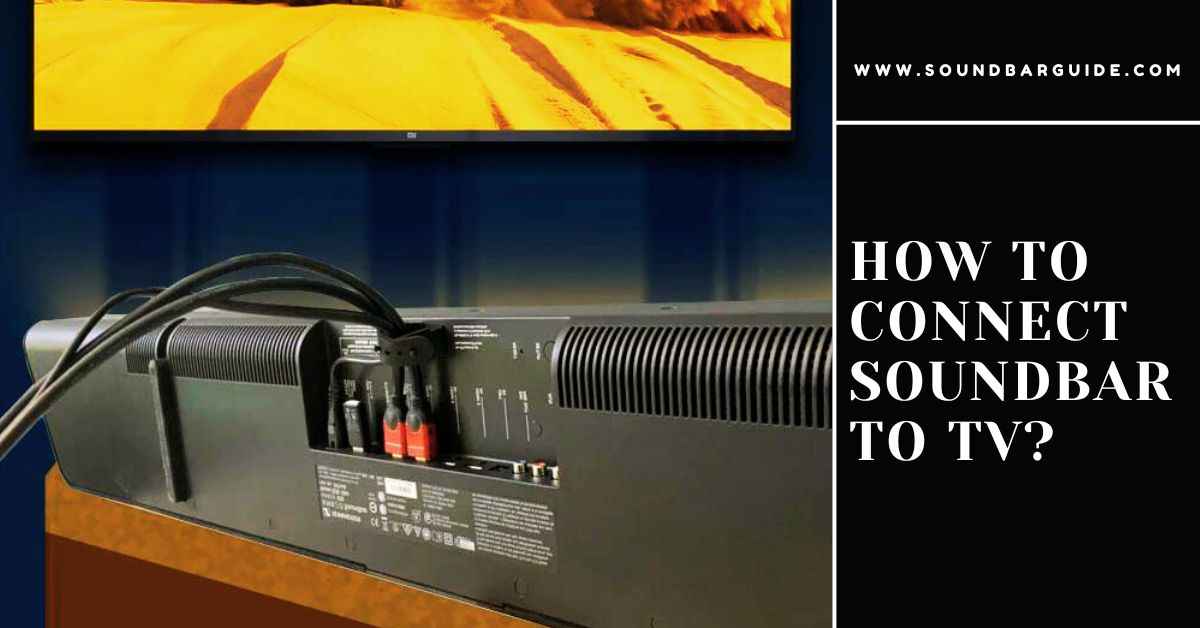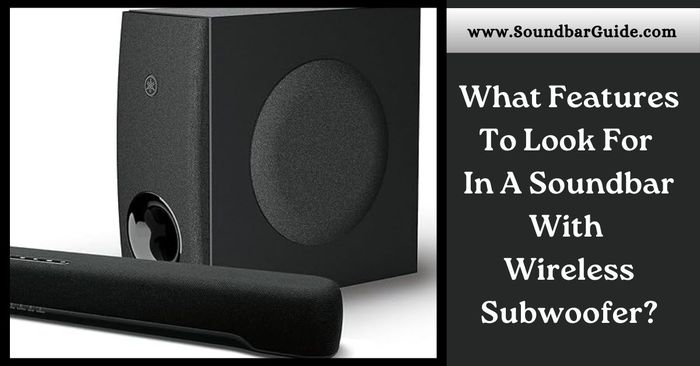To attach a soundbar to your TV, use an HDMI, optical cable, or Bluetooth connection. Ensure your TV output and soundbar input are compatible. Ensuring a proper connection is key to taking full advantage of the soundbar’s capabilities, making movie nights and music sessions far more immersive.
Choosing the right method to connect your soundbar to your TV can greatly enhance your audio experience.
A soundbar, as a slim, high-performance audio device, provides superior sound quality compared to a TV’s built-in speakers.
Whether you’re setting up a home theater or simply upgrading your audio setup, a well-integrated soundbar can transform your listening pleasure.
In this post, I am going to share a step by step guide on how to connect soundbar to tv.
So, let’s dive in…
Table of Contents
Soundbar And TV Connection Basics
Soundbars have become a popular choice for TV audio. They offer a sleek design and superior sound quality. Connecting a soundbar to your TV can enhance your viewing experience.
The Rise Of Soundbars
Soundbars have gained popularity in recent years. They are compact and easy to set up. Many people prefer them over traditional home theater systems.
Soundbars provide excellent sound quality. They are also much easier to install. You can place a soundbar below your TV or mount it on the wall.
Benefits Of Adding A Soundbar To Your TV
- Improved Sound Quality: Soundbars offer crystal-clear audio.
- Space-Saving: They take up less room than large speakers.
- Easy Installation: Setting up a soundbar is simple.
- Stylish Design: They look sleek and modern.
- Enhanced Dialog Clarity: Soundbars improve voice clarity in movies and shows.
| Feature | Benefit |
|---|---|
| Improved Sound Quality | Crystal-clear audio |
| Space-Saving | Takes up less room |
| Easy Installation | Simple to set up |
| Stylish Design | Sleek and modern look |
| Enhanced Dialog Clarity | Better voice clarity |
Types Of Soundbars
Soundbars come in many types. Knowing the right type helps you choose well. This section explores the different soundbar types.
Basic Soundbars Vs. Surround Systems
Basic soundbars are simple and easy to set up. They offer better sound quality than TV speakers. These are great for small spaces and budget-conscious users.
Surround systems include multiple speakers. They create a true surround sound experience. These systems are perfect for home theaters. Expect a more immersive audio experience with them.
| Feature | Basic Soundbars | Surround Systems |
|---|---|---|
| Number of Speakers | 1-2 | 5-7 |
| Setup Complexity | Simple | Complex |
| Sound Quality | Good | Excellent |
| Space Requirement | Less | More |
Features To Consider When Choosing A Soundbar
Selecting a soundbar involves several features. Here are some key points to consider:
- Connectivity: Ensure it has HDMI, Bluetooth, or Wi-Fi.
- Sound Quality: Look for Dolby Atmos or DTS:X support.
- Subwoofer: A built-in or separate subwoofer enhances bass.
- Size: The soundbar should fit your TV and room size.
- Voice Control: Check for Alexa or Google Assistant compatibility.
Choosing the right soundbar involves balancing these features. Aim for the best match for your needs and setup.
Pre-installation Steps For Soundbar And TV Connection
Before connecting your soundbar to the TV, prepare adequately. These steps will help ensure a smooth setup process and optimal sound quality.
Checking TV Compatibility
First, ensure your TV is compatible with your soundbar. Check the TV’s audio output options. Look for ports like HDMI ARC, optical, or AUX. Refer to your TV’s manual for port details. Compatibility is key for a seamless connection.
Gathering Required Cables And Accessories
Collect all necessary cables and accessories. Different soundbars use different cables.
The common types include:
- HDMI cable: Ideal for high-quality audio.
- Optical cable: Another great option for clear sound.
- AUX cable: Suitable for basic connections.
Ensure you have power cables and remote controls. Sometimes, soundbars come with mounting brackets. Check if you need them for your setup. Gather everything in one place to avoid interruptions.
| Accessory | Use |
|---|---|
| HDMI Cable | High-quality audio and video |
| Optical Cable | Clear audio |
| AUX Cable | Basic audio connection |
| Power Cable | Powering the soundbar |
| Remote Control | Controlling the soundbar |
Once you have checked compatibility and gathered all accessories, you are ready to connect your soundbar to the TV.
Read More: How To Pair A Soundbar To A Smart TV?
TV And Soundbar Positioning
Placement affects both sound quality and aesthetics of your setup.
Consider these:
| Room Layout | TV Position | Soundbar Place |
|---|---|---|
| Consider room size and seating | Center at eye level | Directly below or above TV |
| Check for wall mounts compatibility | Sturdy support needed | Ensure soundbar aligns with TV |
- Measure the distance between your TV and where you plan to place the soundbar.
- Determine if additional mounting brackets or stands are needed.
How To Connect Soundbar To TV: Wired Connection
Connecting your soundbar to your TV using wired methods ensures a stable and high-quality audio experience. Below are the most common wired connection methods, each with its unique benefits.
Let’s discover how to set up your soundbar for the best possible sound:
How To Connect Soundbar To TV With HDMI ARC?
HDMI ARC (Audio Return Channel) is one of the best ways to connect your soundbar.
This method allows both audio and video signals to travel through a single HDMI cable.
Follow these steps:
- Check if your TV and soundbar have an HDMI ARC port.
- Connect one end of the HDMI cable to the HDMI ARC port on your TV.
- Connect the other end to the HDMI ARC port on your soundbar.
- Switch your TV’s audio output to HDMI ARC.
This method provides the highest audio quality and supports modern sound formats like Dolby Atmos.
How To Connect Soundbar To TV With Optical Cable?
An optical cable is another great option for connecting your soundbar. It transmits digital audio without interference.
Here’s how to set it up:
- Locate the optical port on your TV and soundbar.
- Insert one end of the optical cable into the optical port on your TV.
- Connect the other end to the optical port on your soundbar.
- Switch your TV’s audio output to optical.
This method is reliable and supports high-quality audio, but it doesn’t carry video signals.
How To Connect Soundbar To TV Using Analog Audio Cables?
If your TV and soundbar don’t have HDMI ARC or optical ports, you can use analog audio cables. These include RCA cables and 3.5mm aux cables.
Follow these steps:
- Find the RCA or 3.5mm aux ports on your TV and soundbar.
- Connect the cables from the TV’s audio out ports to the soundbar’s audio in ports.
- Switch your TV’s audio output to analog.
While analog connections are easy to set up, they don’t offer the same audio quality as digital options.
Choose the method that best fits your devices and enjoy better sound quality on your TV.
How To Connect Soundbar To TV: Wireless Connection
Connecting your soundbar to your TV wirelessly is convenient. You avoid cable clutter and enjoy a seamless audio experience.
There are two primary wireless connection methods: Bluetooth and Wi-Fi. Each has its own set of advantages and compatibility factors.
How To Connect Soundbar To TV With Bluetooth?
Bluetooth pairing is easy and quick. Most modern soundbars and TVs have Bluetooth capabilities.
Follow these steps to connect your soundbar to your TV using Bluetooth:
- Turn on the Bluetooth feature on both your TV and soundbar.
- Navigate to the Bluetooth settings on your TV.
- Select your soundbar from the list of available devices.
- Confirm the pairing request on both devices.
Once paired, your soundbar will play audio from your TV wirelessly. Bluetooth pairing is ideal for short-range connections and quick setups.
How To Connect Soundbar To TV Via Wi-Fi And Soundbar Apps?
Wi-Fi connections provide higher quality audio. They are more stable for long-range connections. Many soundbars come with dedicated apps that facilitate Wi-Fi pairing.
Here’s a step-by-step guide:
- Download and install the soundbar’s companion app on your smartphone.
- Ensure both your TV and soundbar are connected to the same Wi-Fi network.
- Open the app and follow the on-screen instructions to connect your soundbar.
- Adjust settings and preferences through the app for optimal sound.
Using Wi-Fi and soundbar apps offers advanced features. These include firmware updates and sound customization options.
Soundbar Mounting And Placement Tips
Proper mounting and placement of your soundbar can enhance your audio experience. This guide will help you choose the best spot for your soundbar.
Follow these tips to enjoy clear and immersive sound…
Wall Mounting Vs. Shelf Placement
Wall mounting your soundbar saves space and provides a clean look. It’s ideal for rooms with limited space. Ensure the soundbar is at ear level for the best sound experience. Use a reliable wall mount bracket to secure it firmly.
On the other hand, shelf placement is more flexible. It allows easy access to ports and controls. Place the soundbar on a sturdy shelf beneath the TV. Make sure it’s stable and won’t fall.
| Wall Mounting | Shelf Placement |
|---|---|
| Saves space | Flexible positioning |
| Clean look | Easy access to ports |
| Requires installation | Requires a sturdy shelf |
| Best at ear level | Best beneath TV |
Read: How Do I Mount A Soundbar?
Optimizing Soundbar Positioning
To optimize soundbar positioning, follow these simple tips:
- Place the soundbar in the center of the TV.
- Ensure the front of the soundbar is unobstructed.
- Avoid placing the soundbar inside a closed cabinet.
- Keep it away from walls to prevent sound distortion.
If mounting on the wall, measure the distance from the TV. Ensure the soundbar is directly below or above the TV. Use a level to keep it straight. Check the manufacturer’s guidelines for specific mounting instructions.
If placing on a shelf, ensure the soundbar is not blocked by objects. Elevate it slightly if needed. This helps to direct the sound towards the listener.
Remember to keep cables organized. Use cable management solutions to avoid a messy look. This also prevents any interference with the sound quality.
Configuring Sound Settings
Connecting a soundbar to your TV enhances the audio experience. Yet, proper configuration is vital for optimal sound.
Below are steps to configure sound settings effectively:
Adjusting TV Audio Output
First, adjust the audio output settings on your TV.
Follow these steps:
- Navigate to the TV’s Settings menu.
- Select Audio or Sound settings.
- Choose Audio Output or Speaker Settings.
- Set the output to External Speakers or Soundbar.
Ensure the TV volume is at a moderate level. This helps in balancing the soundbar output.
Calibrating Soundbar Settings
Next, calibrate the soundbar settings for the best sound quality.
Follow these steps:
- Use the soundbar remote to access settings.
- Adjust the Bass and Treble levels to your preference.
- Enable Surround Sound if available.
- Set the sound mode to Movie, Music, or Game based on what you watch.
Test the settings by playing different types of content. Fine-tune as needed for a balanced sound experience.
| Step | Action |
|---|---|
| 1 | Navigate to TV’s Settings |
| 2 | Select Audio or Sound |
| 3 | Choose Audio Output |
| 4 | Set to External Speakers |
| 5 | Adjust soundbar settings |
Following these steps ensures a seamless audio experience. Enjoy your movies, music, and games like never before.
Troubleshooting Common Issues
Experiencing issues while connecting your soundbar to your TV? You’re not alone. Many face common problems such as no sound, delayed audio, or connectivity issues.
This guide will help you troubleshoot and resolve these common issues…
No Sound Or Delayed Audio
If there’s no sound from your soundbar or the audio is delayed, try these steps:
- Check if the soundbar is properly connected to the TV.
- Ensure the TV volume is not muted.
- Verify that the soundbar is set to the correct input source.
- Restart both the TV and soundbar.
- Update the firmware on your soundbar.
If the audio is delayed, check the audio settings:
- Go to the TV’s audio settings menu.
- Look for an option called “Audio Delay” or “Lip Sync.”
- Adjust the settings until the audio matches the video.
Note: If the above steps don’t work, you can try resetting the soundbar.
Resolving Connectivity Problems
Connectivity problems can be frustrating. Here’s how you can fix them:
| Issue | Solution |
|---|---|
| Soundbar not detected | Check the HDMI or optical cable connection. |
| Bluetooth connection failure | Ensure Bluetooth is enabled on both devices. |
| Wi-Fi connection issues | Restart your router and soundbar. |
For HDMI connectivity:
- Ensure the HDMI cable is securely plugged in.
- Use a high-speed HDMI cable.
- Check if the TV’s HDMI port supports ARC (Audio Return Channel).
- Enable the ARC feature in the TV’s settings.
For optical cable connections:
- Ensure the optical cable is securely connected.
- Check if the cable is damaged.
- Switch to a different optical port if available.
By following these steps, you can resolve most connectivity issues quickly.
How To Connect A Soundbar To A TV Video
Now, let’s watch a video tutorial on how to connect a soundbar to a tv…
FAQs On How Do You Connect A Soundbar To A TV
How Do I Connect My Soundbar To Samsung TV?
To connect soundbar to Samsung TV, use an HDMI ARC (Audio Return Channel) cable by plugging one end into the HDMI ARC port on the TV and the other into the corresponding port on the soundbar. Alternatively, you can use an optical audio cable, connecting it to the optical output on the TV and the optical input on the soundbar.
Why Is My TV Not Playing Sound Through My Soundbar?
Your TV might not be playing sound through your soundbar due to incorrect audio settings, a loose or faulty connection, or the wrong input source selected on the soundbar. Check the connections, ensure the soundbar is powered on, and verify that the TV audio output settings are configured correctly to use the soundbar.
What Is The Best Way To Connect A Soundbar?
The best way is using an HDMI ARC cable. It provides the highest audio quality and allows for easier control using your TV remote.
Where Do You Mount A Soundbar Under A TV?
Mount your soundbar directly below the TV, ensuring it is centered and close to the bottom edge for optimal sound projection and aesthetic alignment. Use brackets or a mounting shelf for secure installation.
How To Choose The Perfect Soundbar For My Apartment?
To choose the perfect soundbar for your apartment, consider the size of your space, ensuring the soundbar is compact yet powerful enough to fill the room. Look for features like Bluetooth connectivity, built-in subwoofers, and support for surround sound technologies to enhance your audio experience without cluttering your living area.
Conclusion
Connecting your soundbar to your TV enhances your audio experience significantly. Follow the steps outlined for a seamless setup. Enjoy richer sound quality and an immersive viewing experience. Troubleshoot any issues using the tips provided.
At this point, I can say that you have got a clear understanding of how to connect soundbar to tv.
Still, if you face any technical issue, you can comment below…


![How To Connect Vizio Soundbar To Vizio TV: [Step By Step Guide]](https://soundbarguide.com/wp-content/uploads/2024/10/how-to-connect-vizio-soundbar-to-vizio-tv.jpg)


Leave a Reply